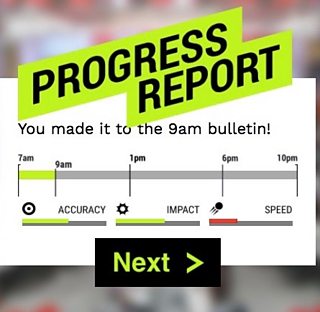The interactive game training the next generation of news reporters
Andrew Leimdorfer
Senior Product Manager, News
Tagged with:
Βι¶ΉΤΌΕΔ News, Βι¶ΉΤΌΕΔ Design + Engineering and Aardman Animations have teamed up to produce an interactive game, giving children a taste of newsroom decisions and pressures. Senior product manager Andrew Leimdorfer explains how it's evolved.
The aims to give players the chance to take on the role of a journalist in the Βι¶ΉΤΌΕΔ newsroom. The game was commissioned by the Βι¶ΉΤΌΕΔ News School Report team, who's mission is to help 11-18 year olds develop their media literacy skills, and is part of a set of resources to use in classrooms across the UK.
The "choose your own adventure" game challenges you to make your own decisions on which sources, political claims, social media comments and pictures should be trusted as you contribute to the day's news output.

The game features video interviews in social media type environments
The idea to use the vehicle of a game to develop these skills first surfaced in Autumn 2017 and, after a competitive tender process, Aardman Animatons were selected as the right partner for the project. Although the basic structure of the game and the key learning points were defined from the outset, the script and gameplay were developed throughout the creative process and user-tested with groups from schools in Bristol and Coventry. The feedback from the youngsters was then incorporated into the design.

Players are presented with a series of editorial choices
While setting out to deliver key editorial learning points, such as the importance of thinking twice before sharing, working out the motives of your sources and spotting obvious fakes and mistakes, the brief was to keep the game engaging and fun for the target audience. The use of social media style interfaces as the main way of delivering the content helped ensure the interactions felt familiar. Aardman also did a great job to keep humour in the story, while delivering the educational points.

Players are under pressure to meet different deadlines
We know from feedback on School Report Day that the initial response has been great. It takes around 20 minutes to complete the game, which is a significant commitment for online content, but we're already seeing high levels of engagement and significant numbers of users playing through the whole game.
However, the success of the project will be judged over the longer term as schools across the UK use the game in the classroom and new cohorts of School Reporters are educated about the pitfalls of fake news, but also inspired by the fast-pace challenge of working in a newsroom.
